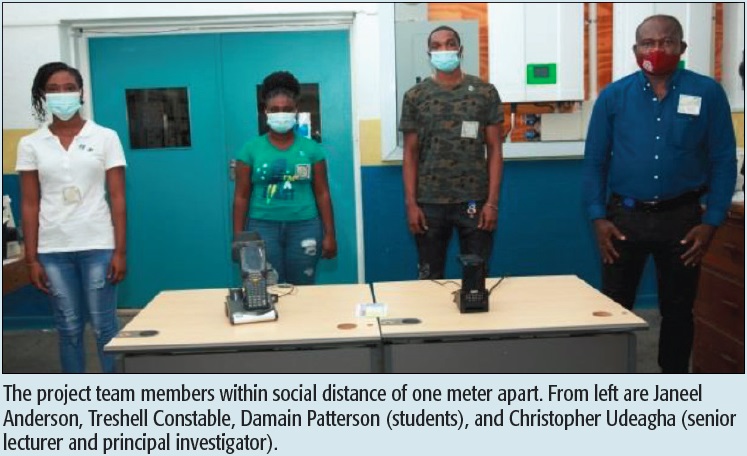
Radio-frequency identification (RFID) is the use of a wireless non-contact system that uses radio-frequency electromagnetic fields to transfer data from a tag attached to an object, for the purposes of automatic identification and tracking of the system. Some tags require no battery and are powered by the electromagnetic fields used to read them. Others use a local power source and emit radio waves.
RFID tags are used in many industries. An RFID tag attached to an automobile during production can be used to track its progress through the assembly line. RFID identity cards can give employees access to locked areas of a building, and RF transponders mounted in automobiles can be used to bill motorists for access to toll roads or parking.
RFID tags can be attached to clothing, possessions, or even implanted within people (mainly criminals) for the purpose of tracking them. Therefore, the possibility of reading personally-linked information in humans without their consents using RFIDs could create an opportunity to monitor social distance, thereby controlling the spread of the Corona Virus of 2019.
At the tail end of 2019, the virus called Corona Virus of 2019 started in Wuhan, China, and has now spread worldwide and has been declared a pandemic by the World Health Organization (WHO). This virus is mainly transmitted through droplets generated when an infected person coughs, sneezes, or speaks. These droplets are too heavy to hang in the air, and quickly fall on floors or surfaces. You can be infected by breathing in the virus if you are within one meter of an infected person, or by touching a contaminated surface and then touching your eyes, nose or mouth before washing your hands.
This work may attempt to design and implement sensitive tags and RF readers for the purpose of social distance monitoring in supermarkets and other public places, and in institutions, at certain radio frequencies to control the wide spread of the virus. Pilot testing will be used to monitor sensitive areas at the Faculty of Engineering & Computing, University of Technology, Jamaica. An algorithm has to be developed so that if cluster of tags within people are detected, an alert sent via text will have to be sent to the RF reader on the network.
The successful implementation of this work can be applied in Jamaica and in the world to control the spread of the virus, thereby solving real-world problems.
How the Project will Work
The top photo shows a typical RFID system. In every RFID system, the transponder Tags (on the shirts) contain information. This information can be as little as a single binary bit, or it can be a large array of bits representing such things as an identity code, personal medical information, or literally any type of information that can be stored in digital binary format.

As shown on the picture above, an RFID reader with the teacher communicates with passive tags on the three students via a transceiver field. Passive tags have no power source of their own and instead derive their power from the incident electromagnetic field. The heart of each tag is a microchip. When the tag enters the generated RF field it is able to draw enough power from the field to access its internal memory and transmit its stored information.
When the transponder tag draws power in this way, the resultant interaction of the RF fields causes the voltage at the transceiver antenna to drop in value. This effect is utilized by the tag to communicate its information to the reader. The tag is able to control the amount of power drawn from the field and by doing so it can modulate the voltage sensed at the transceiver according to the bit pattern it wishes to transmit. Based on the decision transmitted to the micor-processor or computer, it can be determined that social distances are in order or not.
How the Project Will Address Pandemic Issues
This work may attempt to design and implement sensitive tags, and RF readers for the purpose of social distance monitoring in supermarkets and public places, and in institutions, at certain radio frequencies to control the wide spread of the virus in Jamaica and in the world at large.
The Project’s Support to the Community
The pilot testing will be used to monitor sensitive areas at the Faculty of Engineering & Computing, University of Technology, Jamaica. An algorithm has to be developed so that if cluster of tags within people are detected, an alert sent via text will be sent from the RF reader to the display unit on the network. The successful implementation of this work can be applied in Jamaica and in the world to control the spread of the virus, thereby solving real-word problems.
Who are the Project Team Members?
There are six team members in total. Two of the team members are academic staff; one of the team members is from industry; three team members are students of the Faculty of Engineering & Computing, University of Technology, Jamaica.
The team members will ensure that social distancing is maintained. Wearing of masks and laboratory gear will be observed during the design, implementation and prototype testing in the laboratory. We must adhere to all the rules of Covid-19 as stipulated by the Government of Jamaica and the World Health Organization (WH0).
In addition, and to ensure the successful completion of the project, each team member is responsible for a specific assignment.